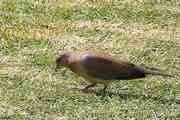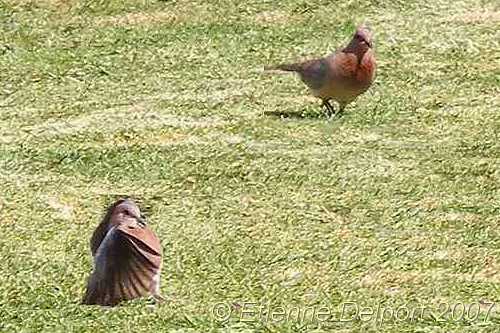| Conservation status | |
|---|---|
| Scientific classification | |
| Kingdom: | Animalia |
| Phylum: | Chordata |
| Class: | Aves |
| Order: | Columbiformes |
| Family: | Columbidae |
| Genus: | Spilopelia |
| Species: | S. senegalensis |
| Binomial name | |
| Spilopelia senegalensis Linnaeus, 1766 |
|
| Multinational names | |
| Afrikaans: | Rooiborsduifie |
| Portuguese: | Rola do Senegal |
| French: | Tourterelle maillée |
| German: | Senegaltaube / Palmtaube |
| Dutch: | Palmtortel |
| Italian: | Tortora del Senegal / Tortora delle palme |
| Spanish: | Tórtola del Senegal / Tórtola Senegalesa |
| Zulu: | uKhonzane |
| Xhosa: | Icelekwane / Uvelemaxhoseni |
| Tswana: | Lephôi / Tsôkwane |
| Swazi: | Lituba |
| Tsonga: | Gugurhwana |
| South Sotho: | Leebana-khoroana / Mphubetsoana |
| Shona: | Njiva |
| Kwangali: | Hamanku / Katere |
| Roberts # | |
| 355 | |
Identification. The Laughing Dove (Spilopelia senegalensis) grows to about 22 to 24 cm in length and weighs between 74 and 120 grams. It is a long-tailed slim bird. Its back, wings and tail are reddish-brown with blue-grey in the wings. In flight, the underwings are rich chestnut. The head and underparts are pinkish, shading to whitish on the lower abdomen. The legs are red. Diagnostic is the black-speckled necklace across the breast. Sexes are similar although the female and juveniles are slightly duller in colour.
Juveniles lack the chest markings.
Habitat. The Laughing Dove is a common and widespread species in scrub, dry farmland and habitation over a good deal of its range, often becoming very tame. It avoids true desert areas. It has adapted well to cities and gardens.
Diet. The Laughing Dove eats grass, seeds, grains, other vegetation and small insects. It is fairly terrestrial, foraging on the ground in grasslands and cultivation.
Call. The Laughing Dove’s chuckling call is a low oo-took-took-oo-roo, with the emphasis on the took-took. Occasionally a nasal scream at one-second intervals is produced in flight or when landing.
Breeding. The Laughing Dove normally places its nest in a low tree, about 3 m from the ground but sometimes as high as 6 m. This species builds a stick nest and lays two white eggs. Breeding happens mainly during the October – November and March – April periods but they do breed throughout the year. Nests are often reused. Male and female participate in the incubation process. The incubation period is 12 to 17 days. The young are ready to fly within 11 days and leave the nest a week later.
South African Distribution. The Laughing Dove occurs throughout South Africa. It is, without a doubt, South Africa’s best known dove.
Port Elizabeth Area. There’s an abundance of Laughing Doves in Port Elizabeth. Frequent visitors to gardens. I’m still to find a spot in Port Elizabeth where they are absent.
Conservation Status – LC (Least Concern)1 This species has an extremely large range, and hence does not approach the thresholds for Vulnerable under the range size criterion (Extent of Occurrence <20,000 km2 combined with a declining or fluctuating range size, habitat extent/quality, or population size and a small number of locations or severe fragmentation). The population trend appears to be stable, and hence the species does not approach the thresholds for Vulnerable under the population trend criterion (>30% decline over ten years or three generations). The population size has not been quantified, but it is not believed to approach the thresholds for Vulnerable under the population size criterion (<10,000 mature individuals with a continuing decline estimated to be >10% in ten years or three generations, or with a specified population structure). For these reasons the species is evaluated as Least Concern.
- IUCN Redlist – Laughing Dove Fact Sheet ▲



